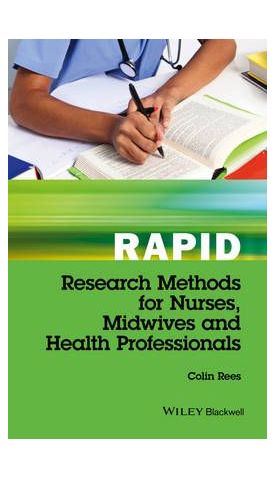אנו משתמשים ב-Cookies כדי לשפר את החוויה שלך. כדי לקיים ההנחיה החדשה של e-Privacy, עלינו לבקש את הסכמתך להגדיר את ה-Cookies. קבלת מידע נוסף.
147.00 ₪
Rapid Research Methods for Nurses, Midwives and Health Professionals
147.00 ₪
ISBN13
9781119048411
יצא לאור ב
New York
עמודים / Pages
144
פורמט
Paperback / softback
תאריך יציאה לאור
22 בינו׳ 2016
שם סדרה
Rapid
Rapid Research Methods for Nurses, Midwives and Health Professionals is designed to help you find and understand the meaning of key research terminology and, more importantly, develop your knowledge of some of the essential ideas and concepts they describe.
Rapid Research Methods for Nurses, Midwives and Health Professionals is designed to help you find and understand the meaning of key research terminology and, more importantly, develop your knowledge of some of the essential ideas and concepts they describe. This A-Z dictionary of terms is a collection of over 200 entries with a definition of each word put in context with additional tips on its use in assignment work. Alphabetically arranged in an accessible, reader-friendly format, this book: * Answers a clear demand for a practical, fast and concise introduction to the key ideas, concepts and methods in nursing and healthcare research * Provides students with fast and accessible information designed for revision and writing research-based assignments * Demystifies a field of study that students often find daunting
| עמודים / Pages | 144 |
|---|---|
| פורמט | Paperback / softback |
| ISBN10 | 1119048419 |
| יצא לאור ב | New York |
| תאריך יציאה לאור | 22 בינו׳ 2016 |
| תוכן עניינים | Introduction xi Abstract 1 Accidental sampling 1 Action research 2 Aim 3 Analysis of Variance (ANOVA) 4 Analysis of Covariance (ANCOVA) 5 Anonymity 6 Audit 7 Audit trail 8 Back chaining 9 Bar graph 10 Before and after designs 11 Beneficence 12 Bias 13 Blinding 14 Bracketing 15 Case control study 16 Causal relationship 17 Cell 18 Chi-square test ( 2) 19 Clinical trial 19 Closed (close-ended fixed choice) questions 20 Cluster sample 21 Coding 22 Cohort study 23 Concept definition 24 Confidentiality 25 Confirmability 26 Confounding variable 27 Contingency table 27 Control group 28 Convenience sample 29 Correlation 30 Covert observation 31 Credibility 32 Cross-over design 33 Cross-sectional study 34 Critique 35 Data 36 Database 37 Data saturation 38 Demographic data 39 Dependent variable 40 Descriptive statistics 41 Double-blind study 42 Ethics 43 Ethics committee 45 Ethnographic research 46 Exclusion criteria 46 Experimental design 47 Ex post facto studies 49 Face validity 50 Fieldwork diary 51 Fieldwork 52 Findings 53 Fittingness 54 Focus group 55 Forward chaining 56 Frequency distribution 57 Generalisability 58 Grey literature 59 Grounded theory 60 Hawthorne effect 61 Hermeneutics 62 Heterogeneity and homogeneity 63 Hierarchy of evidence 64 Histogram 65 Homogeneity 65 Hypothesis 66 Inclusion and exclusion criteria 67 Inferential statistics 68 Independent variable 69 Informed consent 70 Interval data 70 Interviews 71 Inverse relationship 72 Judgemental sample 73 Justice 73 Key informant 74 Key words 75 Levels of measurement 76 Likert scale 78 Literature review 79 Manipulation 80 Masking 80 Measures of central tendency 81 Mean 81 Measures of dispersion 82 Meta-analysis 83 Mode 83 Median 83 Naturalistic research 84 Non-maleficence 84 Nominal data 84 Non-probability sampling methods 85 Normal distribution 86 Null hypothesis 86 Observation 87 Observational designs 88 Open questions 89 Operational definition 90 Opportunity sample 90 Outliers 91 Ordinal data 91 p Values 92 Paradigm 95 Phenomenology 96 PICO 96 Pilot study 97 Population 98 Power analysis 99 Pretest posttest designs 99 Principles of research 100 Probability sampling methods 100 Prospective and retrospective study designs 101 Qualitative research designs 102 Quantitative research designs 104 Quasi-experimental research 105 Questionnaires 106 Quota sampling 106 Randomisation 107 Randomised controlled trials (RCTs) 108 Range 108 Ratio data 108 Reflexivity 108 Reliability 109 Research 110 Research design 111 Research method 112 Response rate 112 Retrospective study 112 Review of the literature 112 Rigour 113 Sample 114 Sampling methods 114 Sampling frame 116 Self-report 116 Snowball sample 116 Social desirability 116 Statistical analysis 116 Survey 117 Systematic reviews of the literature 117 Table 118 Thick data 119 Transferability 119 Triangulation 119 Trustworthiness 119 Type I Type II Type III errors 120 Unstructured interviews 122 Unstructured observations 123 Validity 124 Variable 126 |



Login and Registration Form